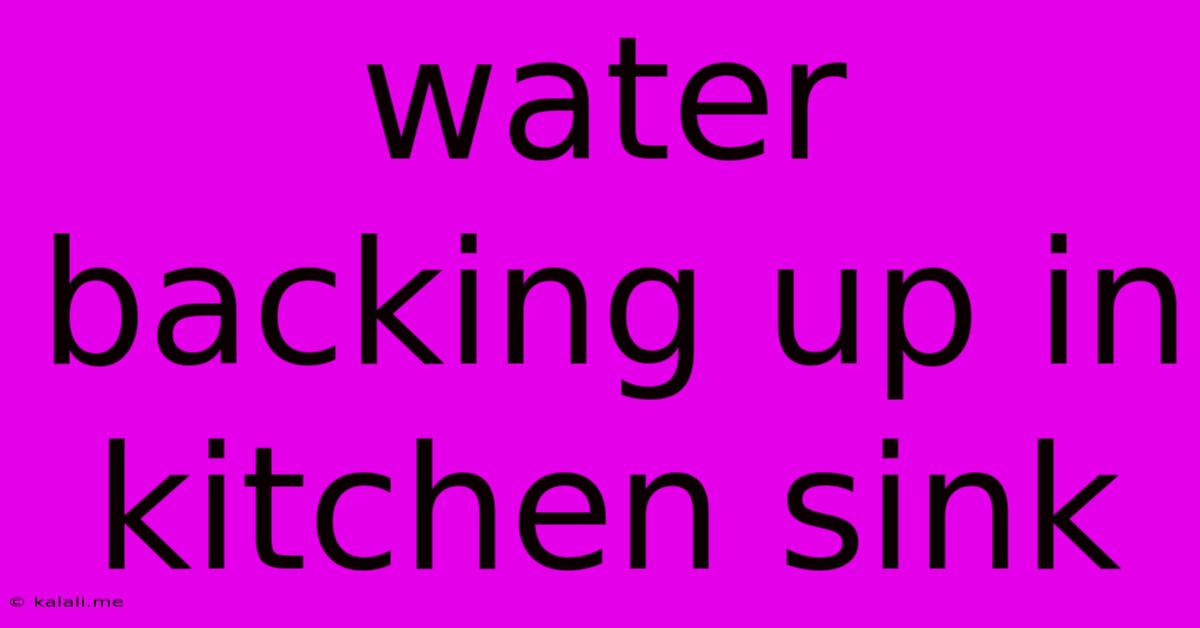Water Backing Up In Kitchen Sink
Kalali
May 24, 2025 · 3 min read

Table of Contents
Water Backing Up in Kitchen Sink: Troubleshooting and Solutions
Meta Description: Dealing with a backed-up kitchen sink? This comprehensive guide explores common causes, from simple clogs to serious plumbing issues, offering effective troubleshooting steps and DIY solutions. Learn how to identify the problem and fix it quickly!
A backed-up kitchen sink is a frustrating and potentially messy problem. Luckily, most issues can be resolved with some simple troubleshooting and DIY repairs. This guide will walk you through common causes and provide solutions, from unclogging drains to addressing more serious plumbing problems.
Identifying the Source of the Clog
Before diving into solutions, it's crucial to pinpoint the source of the backup. Is the problem isolated to your kitchen sink, or are other drains affected? This helps determine the scope of the issue.
- Sink-Specific Issues: If only your kitchen sink is backing up, the clog is likely localized within the sink drain or its associated pipes. This is often the easiest to fix.
- Multiple Drain Issues: If other drains in your house (bathroom sinks, shower, toilet) are also backing up, the problem is probably more extensive, potentially a main drain blockage or sewer line issue. This requires more serious attention.
Common Causes and Solutions for a Backed-Up Kitchen Sink
1. Simple Clogs: These are often the easiest to fix.
- Food Scraps and Grease: This is the most frequent culprit. Avoid pouring grease down the drain. Use a plunger to dislodge the clog. If that doesn't work, try a drain snake (plumber's snake) to reach and break up the blockage.
- Hair and Soap Scum: Especially prevalent if you have a garbage disposal, hair and soap scum can build up and restrict water flow. Use a drain cleaner specifically formulated for hair removal (follow instructions carefully!), or try a chemical drain cleaner as a last resort (always ventilate the area well).
- Foreign Objects: Sometimes, small objects like utensils or toys can accidentally fall down the drain. Using pliers or tongs to retrieve these might be necessary.
2. P-Trap Blockages: The P-trap is the curved pipe under your sink; it traps debris and prevents sewer gases from entering your home. A clogged P-trap is a common problem.
- Disassemble and Clean: Place a bucket under the P-trap to catch any water. Carefully loosen the slip nuts connecting the P-trap and remove it. Clean out any accumulated debris. Reassemble the P-trap, ensuring a tight seal.
3. Garbage Disposal Issues: If you have a garbage disposal, it might be the source of the backup.
- Reset the Disposal: Most disposals have a reset button (usually a small red button) on the bottom. Try resetting it.
- Manual Clearing: Use tongs or pliers to remove any visible obstructions. Never put your hand into the disposal.
- Jammed Motor: If the disposal hums but doesn't turn, the motor might be jammed. You might need a professional to diagnose and fix this.
4. Main Drain or Sewer Line Clogs: These are more serious issues.
- Sewer Line Backup: Look for signs of sewage backing up into other drains. This is a serious issue requiring professional plumbing services.
- Tree Roots: Tree roots can infiltrate sewer lines and cause blockages. This often requires professional excavation and repair.
When to Call a Plumber
While many minor clogs can be resolved with DIY methods, some situations warrant calling a professional plumber:
- Persistent Backups: If the problem recurs frequently, despite your efforts.
- Sewer Line Issues: If you suspect a main drain or sewer line blockage.
- Complex Plumbing Issues: If you're uncomfortable working with plumbing or lack the necessary tools.
- Slow Draining: Even if not fully backed up, persistently slow draining can indicate a larger underlying problem.
By following these steps, you can effectively troubleshoot and resolve most kitchen sink backups. Remember safety first, and don't hesitate to call a professional when needed. A properly functioning kitchen sink is essential for a smooth-running household!
Latest Posts
Latest Posts
-
Linux How To Find Directory Size
May 25, 2025
-
A Man Is A Provider Bible Verse
May 25, 2025
-
How To Start A New Pokemon Sun Game
May 25, 2025
-
How Do You Stop A Text Message From Sending
May 25, 2025
-
Water Smells Like Rotten Eggs Only One Faucet
May 25, 2025
Related Post
Thank you for visiting our website which covers about Water Backing Up In Kitchen Sink . We hope the information provided has been useful to you. Feel free to contact us if you have any questions or need further assistance. See you next time and don't miss to bookmark.